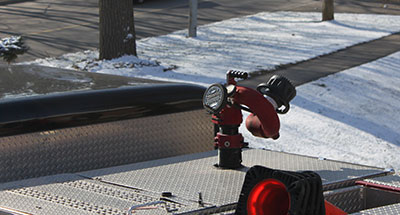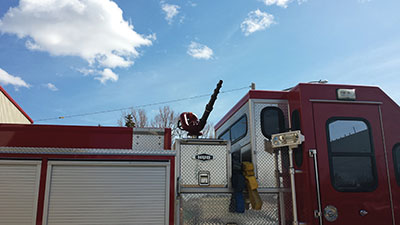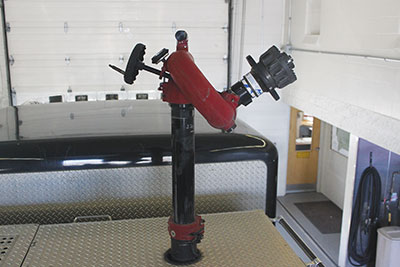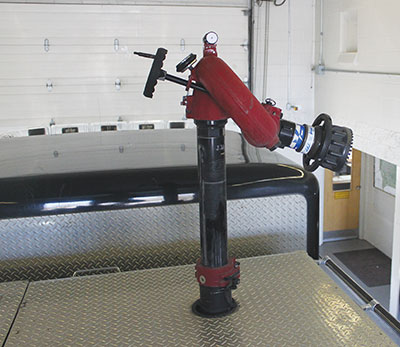
Features
Training
Back to Basics: June 2014
The primary job function of an engine company is to suppress fire by using different-sized hoses and delivering water from its source to the fire.
June 2, 2014
By Mark van der Feyst
The primary job function of an engine company is to suppress fire by using different-sized hoses and delivering water from its source to the fire. One such method of water delivery is master streams.
Engine companies have a few options when it comes to master streams. Most engines have a fixed master stream device on top of the apparatus (see photo 1). This device is armed with either a straight-tip nozzle or a combination nozzle. The advantage of a straight tip is its reach when flowing water. A straight tip provides a true straight stream or solid stream of water for better fire penetration and fire knockdown (see photo 2). Tip sizes can vary in diameter from 35 millimetres (1 3/8 inches) to 50 mm (two inches).
 |
|
| Photo 1: Many engine companies have a fixed master-stream device attached to the top of the apparatus for fire-suppression operations. |
|
 |
|
| Photo 2: A straight tip provides a solid and straight stream of water, making it effective for fire penetration and fire knockdown operations. |
|
 |
|
| Photo 3: Some master streams can be raised about 0.6 metres (two feet), offering a full 360-degree rotation for water application and providing firefighters with an ergonomic work environment. | |
 |
|
| Photo 4: The master-stream nozzle can be positioned below or above the zero-degree horizontal plane, allowing the stream to combat a fire above the apparatus or in a sub-level area of the structure. photos by Mark van der Feyst |
A combination nozzle provides a straight stream pattern but not a solid stream of water. Instead, the stream comprises many droplets of water in a straight-stream pattern. The stream patterns can vary, from straight stream to a wide fog, which is useful to protect the apparatus when it is exposed to radiant heat.
A firefighter must be assigned to operate the master stream on top of the engine and ensure that the stream is appropriately directed for effective fire suppression. This operation takes one firefighter away from the engine crew, leaving a three- or four-person crew.
Some master streams can be extended upward by about 0.6 metres (two feet), as shown in photo 3. This offers an ergonomic work environment for the firefighter operating the master stream, removing the need to squat and preventing a sore back and bothered knees. Having an elevated nozzle also improves the ability to achieve many different angles of water flow. When the master stream is extended, it can apply water in a 360-degree rotation. With the master stream retracted, the cab of the apparatus may be in the way, preventing the complete 360-degree rotation and water application.
The master stream can also be controlled horizontally, and can be lowered or raised to either 90 degrees below the horizontal zero-degree plane, or 90 degrees above the horizontal zero-degree plane. This wide operating range is advantageous because it allows members of the engine company to apply water into the windows of a single-storey building, or into the sub-level portion of a building. In photo 4, the nozzle is pointed below the zero-degree horizontal plane. Knowing how the master stream operates and what it can do is the key to effective engine-company operations.
A truck-mounted master stream is often used for defensive fire operations, but this large water cannon can also be used for a quick offensive attack from the outside of a structure before crews go in and suppress the fire with regular-sized hoselines. The amount of water that a master stream delivers is vast compared to a handline – why not use this for a quick knockdown?
A typical master stream delivers between 500 gallons and 1,250 gallons per minute (gpm) of water or up to 4,500 litres per minute. Some master streams deliver 5,000 liters per minute, or 1,325 gpm. That is a lot of water!
Fire produces energy and to combat that energy, water is needed – lots of water. A BTU – or British Thermal Unit – refers to the amount of heat required to raise the temperature of one pound of water by one Fahrenheit degree. The more BTUs the fire produces, the more gpms that are needed to extinguish it.
Class A combustibles – the kinds of materials found in homes 30 years ago, such as wood, paper, fabric, plastics, and most kinds of trash – produce between 7,000 and 8,000 BTUs. Today, the plastics and composite materials in homes burn at higher BTUs – between 12,000 and 18,000 BTUs. Much more water is required to suppress fires that burn at these higher BTU measurements.
The master stream delivers a large amount of water in a very short amount of time. If an engine carries about 500 or 1,000 gallons of water on board, knockdown can be achieved within a few seconds. This may be all that is needed to control a fire before crews commence an interior attack. While the master stream works to control the fire, crews should work to secure a water source so that a continual water supply can be maintained for continual master-stream operations. For example, crew members on the first-arriving apparatus can hit the hydrant and lay in a supply line; while the master stream uses tank water, crew members secure and open the hydrant, and get water flowing to the apparatus once the operator has the other end of the supply line hooked up to the intake.
An advantage of the master stream is the safety factor it provides. Whether the master stream is truck-mounted or a ground-deluge type, it allows for distance to be placed between the firefighters and the fire or danger zone. When signs of imminent collapse are present, or there is a large fire load, the master stream will still provide water and thermal protection but from a distance that will protect firefighters.
A master stream is a great tool for first-arriving apparatuses and for minimum-staffed departments; while waiting for other resources, apply the master stream for a quick knockdown so that the fire will not spread. This involves a minimum of three firefighters: one to secure the hydrant, one to operate the pump panel and one firefighter to operate the master stream. If only two firefighters are available, then a bit more time will be needed to secure the hydrant with the one firefighter, advance the truck to the desired spot, establish the water supply, then have the hydrant firefighter make his or her way back to the fire apparatus, set up the master stream and then start flowing water.
In a rural response area where there are no hydrants, a master stream can be used with rural water operations. It may take some time to set up the water supply with the porta-tanks but once established, large volumes of water can be delivered. The concept of a tanker-engine works well in rural areas as the tanker-engine can carry up to 2,000 gallons of water, which can be used to supply a master stream for a short duration, achieving a knockdown of some type or even a temporary stop to the growth of the fire.
Practise deploying the master stream: pull up to an address and practise emptying the tank while simultaneously securing a hydrant; see how long it takes to empty, how quickly the hydrant can be secured and how effective the master stream can be.
Mark van der Feyst is a 15-year veteran of the fire service. He works for the City of Woodstock Fire Department in Ontario. Mark instructs in Canada, the United States and India and is a local-level suppression instructor for the Pennsylvania State Fire Academy and an instructor for the Justice Institute of B.C. Email Mark at Mark@FireStarTraining.com
Print this page